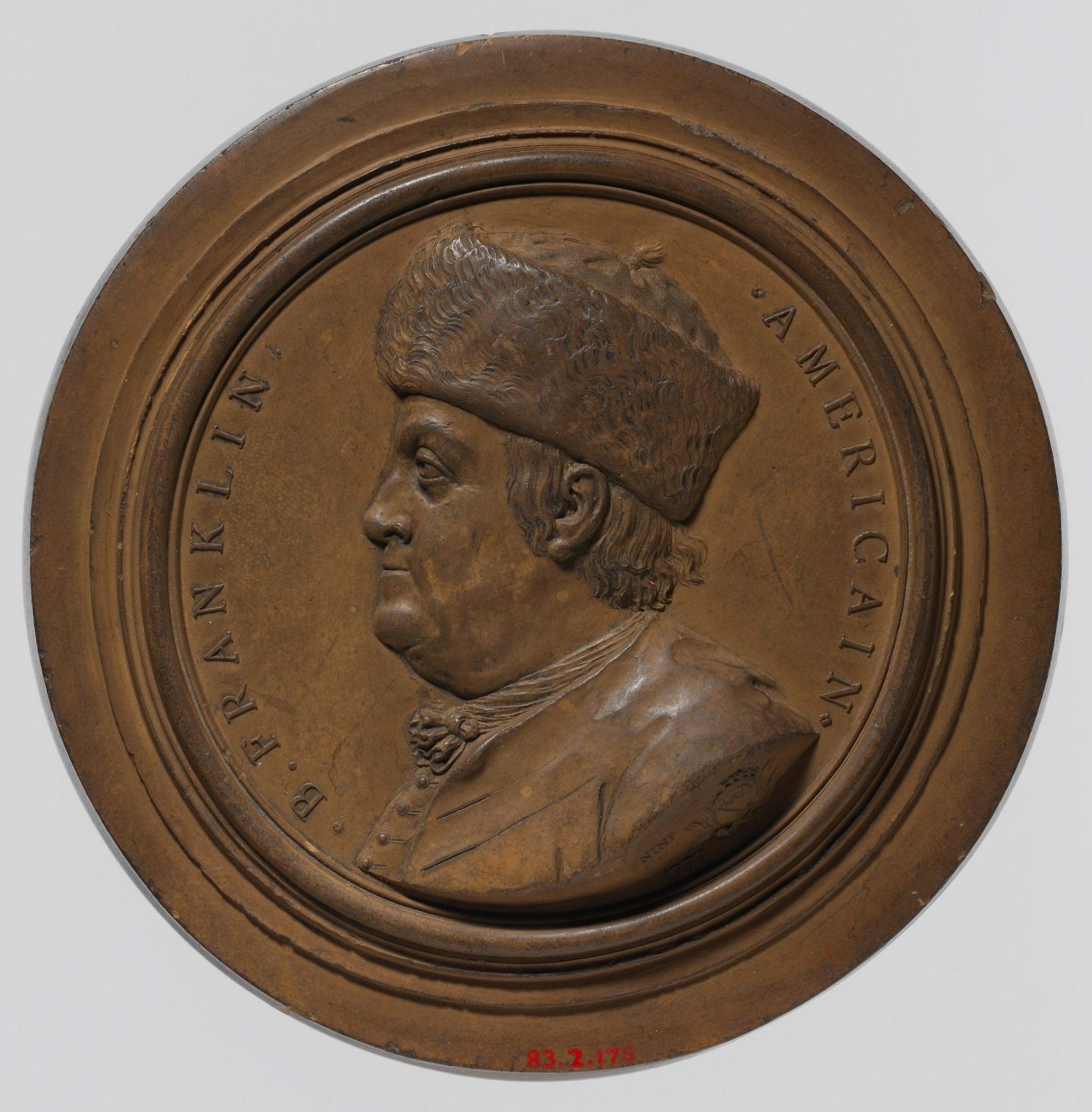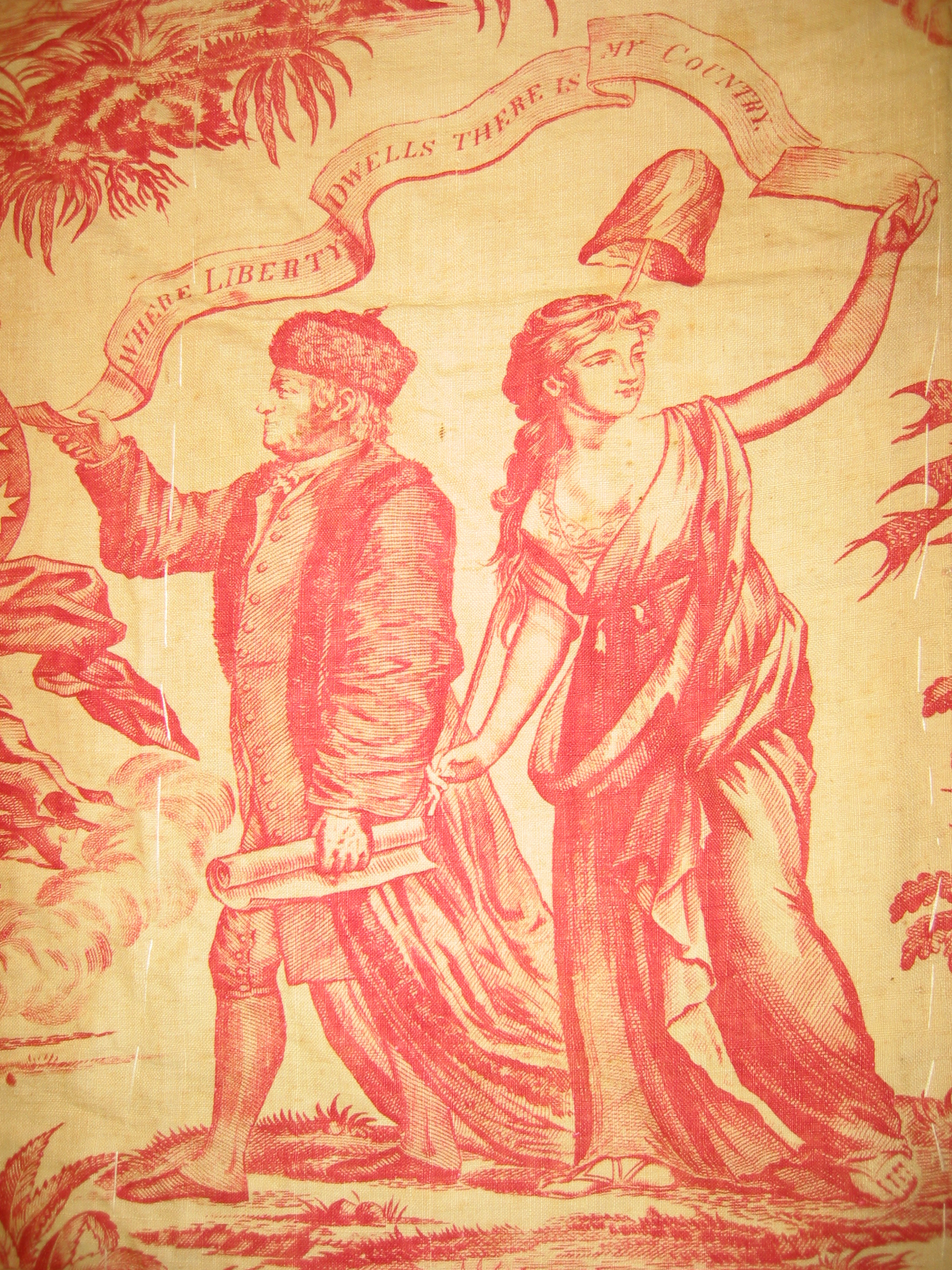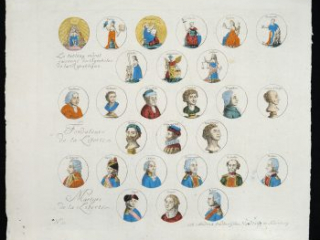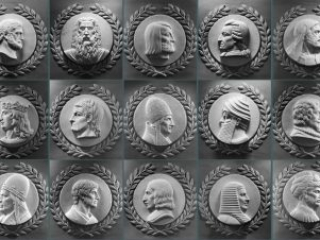In 1789, America was still putting the finishing touches on its new republic when contemporaries in France called for their own revolution, evoking many of the republican ideals, Classical heroes and Enlightenment thinkers admired by America’s revolutionary generation. Le tableau moral raisonné des symboles de la république : foundateurs de la liberté : martyrs de la liberté, an engraving created in 1794 as a visual guide to educate “children of freedom” about France’s path to republican government, includes a nod to American “founders of liberty” George Washington and Benjamin Franklin—underscoring the kindred nature of the French and American struggles to free their nations from the bonds of European monarchy. This lesson explores how late eighteenth century America’s newly enshrined ideals, heroes and influences—and the American Revolution itself—have inspired political and social reform movements around the world for over two hundred years.
Suggested Grade Level
Middle and High School
Recommended Time Frame
Two or three fifty-minute sessions

Benjamin “Francklin” is one of two American “Foundateurs de la Liberté” celebrated in the eighteenth century French engraving Le Tableau Moral Raisonné des Symboles de la République.
Objectives and Essential Questions
Students will:
- examine the ideological influences of the American and French revolutions,
- learn about the historical figures who championed the ideals valued by democratic republics, and
- understand how these republican ideals inspired later political and reform movements around the world and continue to inspire movements for change.
Materials and Resources
(in order of appearance)
- Le tableau moral raisonné des symboles de la république : foundateurs de la liberté : martyrs de la liberté, Nürnberg: Joh. Andreä Endterische Handlung, ca. 1794
- About Relief Portrait Plaques of Lawgivers webpage

B. FRANKLIN, AMERICAIN, a medallion created by Jean-Baptiste Nini in 1777, was one of the first and most popular of all the French reflections of Benjamin Franklin. In it Franklin wears a fur cap Nini etched from a 1766 drawing by Alan Ramsay of Jean-Jacques Rousseau—another of the “Foundateurs de la Liberté” immortalized in Le Tableau Moral Raisonné des Symboles de la République. When Nini sent his design to Paris for approval, he included the suggestion that Franklin instead wear a liberty cap—an acknowledgment of the Revolution underway in America. Instead the original fur cap, or “bonnet de peau,” was accepted—even if it was not precisely true to what Franklin had been wearing at the time.
Background Knowledge
Students should possess background knowledge about the significant ideas, events and individuals of the American Revolution, including an understanding of the role played by France during the Revolution. Students should also be familiar with France’s progression from monarchy to republic in the late eighteenth century. Finally, students should appreciate the growth of the international reputations of Benjamin Franklin and George Washington, which had reached iconic status by 1794—the year Le Tableau appeared in France.
Sequence and Procedure
In 1789, America was still putting the finishing touches on its new republic when contemporaries in France called for their own revolution, evoking many of the republican ideals, Classical heroes and Enlightenment thinkers admired by America’s revolutionary generation. Le tableau moral raisonné des symboles de la république : foundateurs de la liberté : martyrs de la liberté, an engraving created in 1794 as a visual guide to educate “children of freedom” about France’s path to republican government, includes a nod to American “founders of liberty” George Washington and Benjamin Franklin—underscoring the kindred nature of the French and American struggles to free their nations from the bonds of European monarchy.
As a class, view Le tableau moral raisonné des symboles de la république : foundateurs de la liberté : martyrs de la liberté. In pairs or small groups, ask students to find familiar words and individuals in the illustration and decide what overall message they think the tableau is meant to convey.
After discussing student ideas about the tableau, explain that the print was created in France around 1794—the second year of the French Revolution’s Reign of Terror. Introduce the three categories of illustration on the print: republican symbols, founders of liberty and martyrs of liberty. Inform students that leaders of the French Revolution who died in battle, or by assassination or execution were christened “martyrs of liberty.”
Randomly assign student groups or pairs one of the tableau’s nine republican symbols (nature, reason, philosophy, liberty, equality, fraternity, unity, indivisibility or justice) and one of its nine founders of liberty (Jean-Jacques Rousseau, Voltaire, Benjamin Franklin, Lycurgus of Sparta, George Washington, Cato of Utica, Lucius Junius Brutus, William Tell or Demosthenes). Ask students to research the symbol to discover why it is ideologically significant to a democratic republic. Next, have students research the founder to learn what republican thoughts, ideals or actions for which the individual is known. After students have completed their short research assignments, have them share what they discovered with the class. Ask students to propose and defend nine heroes or leaders to memorialized in a tableau commemorating the American Revolution (in place of category made up exclusively of martyrs).
As a class, generate a list of global or international political and reform movements and revolutions occurring after the American and French revolutions (democracy, colonial independence, environmental conservation, gender equality, human trafficking and slavery, LGBTQ+ rights, public health, racial equality, reproductive rights, rights of the unborn, technology and human rights, voting rights, worker rights, etc.). Choose one topic the class is familiar with, and ask students to identify what goals, ideals and individuals are likely to have inspired the movement, recording the group’s answers on a K/W/L chart (which tracks what a student Knows about a subject, what they Want to know about it, and—after researching the subject further—what the student has Learned). As a class, identify the goals and ideas this social movement had or has in common with the tableau’s nine republican symbols and nine founders of liberty, as well as any of the leaders of the American Revolution previously identified by the class who might be considered influential.
Assessment and Demonstration of Student Learning

Benjamin Franklin’s iconic international profile as captured by Jean-Baptiste Nini in 1777 reappeared in a textile produced in England ca. 1785 called Washington and American Indepedance, The Apotheosis of Franklin. This piece, pairing Franklin with a Neoclassical Liberty—a “Symbole de la République”—prefigures the popular thematic mix of allegorical and historical icons in 1794’s Le Tableau Moral Raisonné des Symboles de la République.
Invite students to choose a political or reform movement or revolution to research on their own. This research should result in the identification of three “symbols” or ideals espoused by the movement and in common with the ideals of America’s revolution, three “founders” or individuals whose work or accomplishments inspired the later movement—including at least one from the American Revolution, and three heroes or leaders of the movement itself who have or will become symbolic to its cause. Students’ nine examples should be supported by primary source evidence. As a final activity, students should create an original tableau in the style of the 1794 example to memorialize the movement, with their nine examples represented with illustrations.
Extension
In the House of Representatives Chamber of the United States Capitol there are twenty-three marble bas-reliefs of lawgivers from ancient and modern history (visit webpage link in Materials and Resources above). Alphabetically, the lawgivers depicted are: Alfonso X, Edward I, Gaius, George Mason, Gregory IX, Hammurabi, Hugo Grotius, Innocent III, Jean Baptiste Colbert, Justinian I, Lycurgus, Maimonides, Moses, Napoleon I, Papinian, Robert Joseph Pothier, Saint Louis, Simon de Montfort, Solon, Suleiman, Thomas Jefferson, Tribonian, Sir William Blackstone. Ask students to investigate one or more of these individuals to learn more about who they were and how their accomplishments contributed to the ideals of representative democracy, the rule of law and America’s republic. Invite students to propose the addition of a twenty-fourth individual who lived in the nineteenth, twentieth or twenty-first century whose work merits inclusion with these storied figures and whose image rightly deserves recognition alongside the others in America’s Capitol.
Revolutionary Achievements Category
Republic, Highest Ideals
Exploring the Revolution Category
The Legacy of the Revolution
Read More about the American Revolution’s Impact on the French Officers who Served in America
The American Revolution marked the beginning of an age of democratic revolutions that swept over France and challenged the old order throughout the Atlantic world. To learn more about the experiences of the French officers who served in the American War of Independence, including those propelled into positions of leadership during the early years of the French Revolution, visit our past exhibit, Revolutionary Reflections: French Memories of the War for America.

La Tableau Moral Raisonné des Symboles de la République
Nürnberg: Joh. Andreä Endterische Handlung, ca. 1794The Society of the Cincinnati, The Robert Charles Lawrence Fergusson Collection
The expenses of the American war drove the French government to insolvency, hastening the outbreak of revolution in 1789. This print reflects the radical transformation of the French Revolution that began in the summer of 1792. Allegorical figures of Liberty, Equality and Fraternity—the optimistic motto of the French Revolution’s first years—are joined by Unity and Indivisibility, the added watchwords of the radical Jacobins who imposed political orthodoxy, and violence, through the Terror. The print includes George Washington, Benjamin Franklin and other classical and Enlightenment “founders of liberty,” alongside nine French leaders of the Revolution who had died in battle, or by assassination or execution, as “martyrs of liberty.”
The Basics [Bas Relief Portrait Plaques of Lawgivers]
various artists, 1950House Chamber, United States Capitol
The twenty-three marble relief portraits over the gallery doors of the House Chamber in the U.S. Capitol depict historical figures noted for their work in establishing the principles that underlie American law. They were installed when the chamber was remodeled in 1949-1950. Created in bas relief of white Vermont marble by seven different sculptors, the plaques each measure twenty-eight inches in diameter. The eleven profiles in the eastern half of the chamber face left and the eleven in the western half face right, so that all look towards the full-face relief of Moses in the center of the north wall. The subjects of the reliefs were chosen by scholars from the University of Pennsylvania and the Columbia Historical Society of Washington, D.C., in consultation with authoritative staff members of the Library of Congress. The selection was approved by a special committee of five Members of the House of Representatives and the Architect of the Capitol.